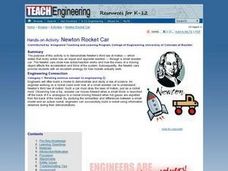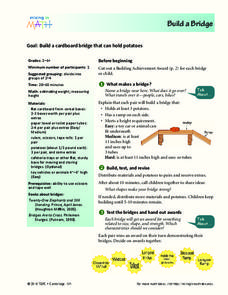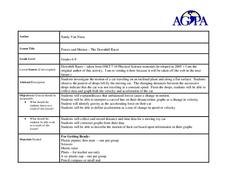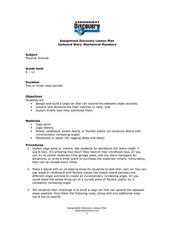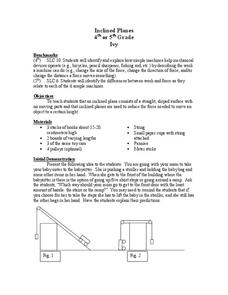Mascil Project
Design and Build Your Own Vacuum Cleaner, Hair Dryer or Toy Car
No vacuum cleaner? No problem, just build your own. Scholars apply knowledge of currents to build a model of either a vacuum clear, a hair dryer, or a toy car. While the class completes the activity, instructors consider gender...
Curated OER
Newton Rocket Car
Students observe a demonstration of Newton's third law of motion using a small wooden car. They discuss Newton's third law of motion and what happens to motion if the mass or acceleration is increased, construct their car, and record...
Curated OER
Build a Cardboard Bridge That Can Hold Potatoes
Students identify the characteristics of a bridge and build with junk materials. In this bridge building lesson, students use cereal boxes, paper towel or toilet paper tubes and tape to create their bridges. Bridges must...
Curated OER
Building Homes
Young scholars investigate architecture and construction by building a home from cardboard tubes. For this housing lesson, students collaborate in groups to plan and create buildings they can fit in made from cardboard tubes,...
Curated OER
Balloon Powered Race Cars
Students examine Newton's Law of Motion and use the formula to calculate speed. In this laws of motion lesson students create a balloon powered car and calculate its speed and distance.
Curated OER
Simple Machines I - Inclined Planes, Wedges, and Screws
The principles and uses of inclined planes, screws, and wedges are the focus of a science lesson. In it, youngsters come up with every day examples of simple machines, and build an example of one in class. That project is then used to...
Curated OER
Junkyard Wars: Mechanical Monsters
Young scholars examine slope and build a Lego car that can take a steep slope. In this mechanics lesson students build a car and demonstrate them in class and describe what they did.
Curated OER
Ride on a Slide
Students investigate gravity and engineering by participating in a slide building experiment. In this early physics instructional activity, students utilize cardboard boxes to create a model of a children's slide. Students...
US Institute of Peace
Mediating Conflict
Two's a negotiation, but three's a mediation! Demonstrate the differences between the two processes through a role-playing lesson plan. The activity familiarizes pupils with the role of a mediator and examines the types of situations...
Curated OER
Maglev Trains
Students explore how Maglev trains work. In this technology lesson, students discuss the pros and cons of Maglev compared to conventional trains. They build a simple Maglev train model.
Curated OER
Community Building
Seventh graders discover the similarities and differences between cities, towns, and rural communities. Using a Neighborhood map Machine, they create a Venn diagram and map of their own community. Students build a 3-D representation of...
Curated OER
Electricity: Will It Conduct?
Students build conductivity testers and investigate which solids and solutions conduct electricity. Working in groups, they predict which items will conduct electricity and record their answers on worksheets.
Curated OER
Wind Power! 2
Fourth graders explore how engineers transform wind energy into electrical energy by building their own miniature wind turbines and measuring the electrical current it produces. They see how design and position affect the electrical...
Lied Center of Kansas
The Ugly Duckling and The Tortoise and the Hare
Both The Ugly Duckling and The Tortoise and the Hare are great additions to an elementary language arts lesson. Young readers focus on the literary elements of each story, including characters and plot development, and apply...
Curated OER
Forces and Motion-The Downhill Racer
Students calculate a toy car's velocity and acceleration. In this force and motion lesson, students build ramps and attach a dropper to a toy car, which is released down the ramp. Students calculate and graph velocity and acceleration...
Curated OER
Mechanical Monsters
Students experiment try to build a Lego car. In this physical science lesson students present and demonstrate the vehicle that they constructed.
Curated OER
Twenty Green Gates
Second graders explore mathematics by participating in a pattern building activity. For this geometric construction lesson, 2nd graders discuss a story problem in which a gate needs to be built from triangles and trapezoids up to a...
Curated OER
All Hands on Deck: A Harbor Education Program
Students build a model of an estuary. In this wetland lesson plan, students build a model estuary with a paint tray and modeling clay. They use the model to illustrate the impact of non-point pollution on the watershed.
Curated OER
Before You Were Mine
Students discuss animal adoption and pet care. In this pet lesson, students listen to the story Before You Were Mine by Maribeth Boelts. They discuss animals body language, feelings, and how to best car for them.
Curated OER
Mechanical Energy
Young scholars discover the difference between kinetic and potential energy in an experiment using toy cars and tracks. In small groups, they set up the experiment to determine the distance milk cartons will travel when hit by toy car....
Curated OER
Inclined Planes
Students break into small groups with each group using 3 books, a board with pulleys attached at both ends, a toy cart, a small paper cup with a long piece of string attached the end and some pennies. They test their guesses to see if it...
Science Matters
Energy Transfer and Transformation
When you take a simple task and create an exceptionally difficult way to complete it, it is known as a Rube Goldberg machine. These machines are filled with many types of energy transfers and energy transformations. Here, pupils...
Teach Engineering
Come On Over Rover
Introduce your class to the steps that occur in the manufacturing of parts, the assembly, and the testing of a Mars rover. Pupils learn about fabrication techniques and tolerances in the manufacturing process.
Curated OER
Scale/Ratio
Investigate the use of ratios in scale drawings. Learners scale objects up or down using ratios then find the actual size of something using ratios. They apply their knowledge of ratios as they make their own telescopes in science...



